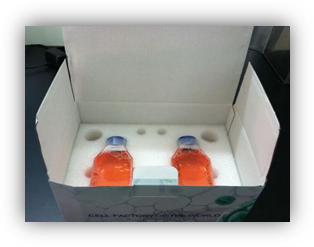Through many times of understanding and feedback from customers, Sai Baijun's after-sales service personnel found that after receiving the professionally packaged cells, the customer directly conducted the experiment because it was not systematically inspected and processed, so that it was easy to produce later. A series of questions. In view of the lack of customer knowledge in this area, the technical staff of Sai Baijun has summarized the following instructions on how to handle the professional treatment of cells:
I. Q: How to deal with cells after receiving them?
A: cells transported at room temperature
First, observe whether the package is intact, whether the bottle mouth is leaking, and then the microscope will take two photos of 4x, 10x, 40x different multiples. After the incubation box was placed in the incubator for two hours, the medium was changed, the adherent cells were all aspirated, and 6 ml of new complete medium was added. After the cells were centrifuged, the cells were resuspended in 6 ml of complete medium. Pay attention to the culture environment of the cells.

Cells that are transported at low temperatures are usually shipped on dry ice.
After the customer receives the cells, observe whether the dry ice is volatilized and the cells are dissolved. No problem can be placed directly in the liquid nitrogen tank for storage (long time), or ultra-low temperature refrigerator (not more than one week).
Second, Q: After the cells are frozen, the recovery effect is not good?
A: At present, there are still many people who take 4° and -20° for half an hour and then transfer to the -80° refrigerator. This method is not easy to control. Some cells are suitable, and some cells do not achieve the desired effect. The program cooling box can be used for freezing, and the isopropanol added in the cooling box can reach the requirement of one degree per minute, and the operation is simple.
The cryopreservation solution used 90% serum + 10% DMSO. Partially poorly differentiated or stem cells can be added to the horse serum for cryopreservation. Alternatively, the cryopreservation solution can be configured as 80% serum + 20% DMSO, and the cells can be resuspended with the serum when the cells are resuspended, thereby avoiding direct damage to the cells by DMSO.
Third, ask: What is the black point of the cell?
A: There are more possibilities in this situation. First, determine whether the black spots are on the cell surface, in the cytoplasm, or outside the cell. The increase in cell surface black spots may be due to poor state, which may be due to unsuitable culture conditions or decreased cell viability. Increased black spots in the cytoplasm, first confirm whether it is a multinucleated cell. There are black spots outside the cells. The black spots may be bacterial contamination. If they do not swim, but the number of black spots increases as the culture time increases, it should be detected whether it is mycoplasma contamination. Most of the suspended cells have black spots, which may be fragments, which can be slow. Remove by centrifugation. Most of the adenocarcinomas are secreted factors, and the number of black spots is increasing.
Fourth, the medium, how to choose serum?
A: It is best to use the same serum as the brand used by the cell source. There is little difference between the import of basic medium and domestic production. The serum used by professional cell companies has been verified by a large number of cell cultures. Do not replace them easily. At present, there are many domestic serum brands and the quality is not uniform.
Laparoscopy Drape,Surgical Laparoscopy Drape,Disposable Laparotomy Drape,Disposable Laparouscopy Surgical Drape
ShaoXing SurgeCare Medical Products Co., Ltd. , https://www.sxsurgecaremedical.com